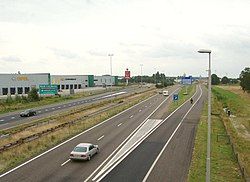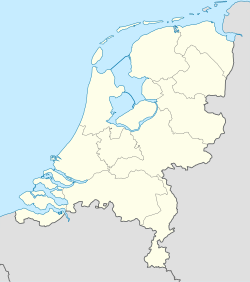Hazeldonk/Meer
This article needs additional citations for verification. (June 2024) |
Hazeldonk | |
|---|---|
Industrial area | |
 Motorway A16 at Hazeldonk | |
| Coordinates: 51°29′11″N 4°44′10″E / 51.48639°N 4.73611°E | |
| Country | Netherlands |
| Province | North Brabant |
| Municipality | Breda |
| Time zone | UTC+1 (CET) |
| • Summer (DST) | UTC+2 (CEST) |
Meer | |
|---|---|
Transport Zone | |
 Aerial photograph Hazeldonk/Meer | |
| Coordinates: 51°29′07″N 4°44′02″E / 51.48528°N 4.73389°E | |
| Country | |
| Region | |
| Province | Antwerp |
| Municipality | Hoogstraten |
| Time zone | UTC+1 (CET) |
| • Summer (DST) | UTC+2 (CEST) |
Hazeldonk (as it is called in the Netherlands) or Meer (as it is called in Belgium) is the busiest border crossing between the Netherlands and Belgium and processes an average of 55,000 vehicles per day. Some sources suggest it is one of the busiest border crossings in Europe. [1]
Here the European route E19 (Amsterdam - Paris) crosses the border and turns from the Dutch A16 (Rotterdam - Hazeldonk) into the Belgian A1/E19 (Meer - Brussels). In Belgium E19 is the primary name for this motorway. Since 1997 the former municipality Hazeldonk belongs to the municipality of Zundert. The border crossing and connecting industrial area belongs to the municipality of Breda. At the Dutch side of the border leis the Serves Station Hazeldonk, which includes fast food restaurants, petrol stations and a hotel.
The Schiphol–Antwerp high-speed railway also crosses the Dutch/Belgium border at Hazeldonk/Meer. The Dutch HSL-Zuid connects here to the Belgium HSL 4.
The name Hazeldonk is mentioned for the first time in 1303, regarding the nearby Dutch civil parishe Hazeldonk. Meer refers to nearby the Belgian village Meer in the municipality of Hoogstraten. The business association at Hazeldonk is a collaboration with Hazeldonk and the Transport Zone Meer and is called "Logistics Center Hazeldonk Meer”.[2]
On the 17th of January 1972 the Dutch Queen Juliana and her Belgian colleague King Baudouin officially opened the new E10 road between Antwerp and Rotterdam. (Tis road is now known as E19). On that day there was no border control office and freight traffic stil needed to use the old N263 via Wuustwezel and Zundert. Later in 1984 a customs post 'Breda' was realised.
On initiative of the Provincial states of Noord-Brabant a distribution center was built on Dutch grounds next to the customs office. On the opposed side in Belgium the ‘Transport Zone Meer’ arose. This was the start of the international transport hub as it is today. [3]
Due to the Schengen acquis there is free movement of persons and goods between the Netherlands and Belgium, although there are regular inspections by mutual customs.[4] The Dutch and Belgian police forces also work closely together and can freely continue their work on both sides of the border, including in priority pursuit of a suspicious vehicle.
References
[edit]- ^ "179. Hazeldonk – de grens is nog goed voelbaar". Grensfietsen.NL. April 2, 2021.
- ^ "Ondernemers op Hazeldonk slaan handen ineen". bndestem.nl (in Dutch). 24 July 2019.
- ^ "Hazeldonk". Erfgoedweb Breda.
- ^ "Vluchtelingen in koelwagen Hazeldonk vernikkelden van de kou". RTL.nl. February 10, 2017.




